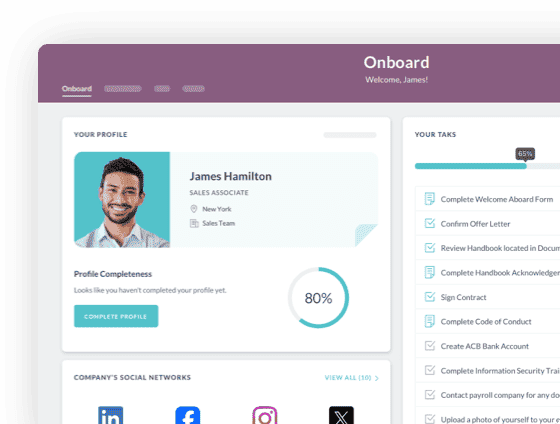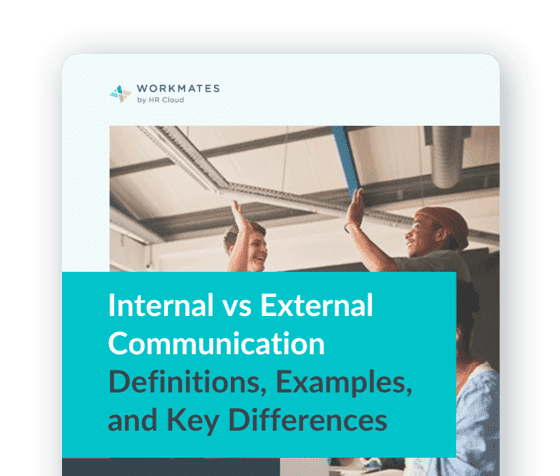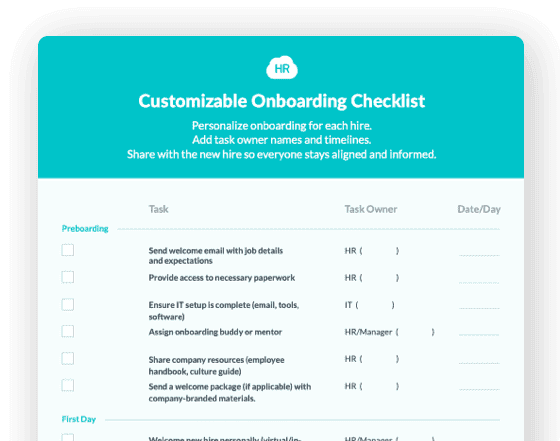

 Cut onboarding time
by 60%—here's the
Ultimate Checklist
that helped do it.
Cut onboarding time
by 60%—here's the
Ultimate Checklist
that helped do it.

ONBOARDING, QUITE SIMPLY, is bringing a newly hired employee “on board.” However, as simple as that sounds, a lot of effort, planning and interdepartmental collaboration is needed to accomplish the end result. Onboarding, if done right, leads to early productivity, excitement, and increased engagement of new hires. Not only that, onboarding makes new employees comfortable in their work environment and cognizant of collegial relationships and assignments and how they matter to overall company objectives.
An organization’s acquisition of new talent is never questioned as to its importance in corporate day-to-day operations and future prosperity. There is no doubt that recruiting and applicant processing are mandatory to meet any organization’s workforce utilization demands. In fact, organizations with insight and vision are always striving to anticipate future workforce demands.
Indeed, workforce planning is a critical component in determining the viability and longevity of any organization, as is onboarding. The same level of planning, detail, and interdisciplinary collaboration must be in place to make sure that the newly hired employee remains a productive and engaged employee.
A new hire’s choice to stick with a company or move on largely hinges on initial impressions, yet many organizations put only a small amount planning into that important first-touch experience—the onboarding process.1
There are many definitions of onboarding, including one put forth by Workforce Magazine:1
“Onboarding is the first experience new hires have with the company, and the process by which they are introduced into the company. The best onboarding programs combine tactical tasks, such as benefits paperwork and desk assignments, with cultural training so employees understand how the company works and how they will fit into that environment. Ideally it is a joint effort between HR, the information technology department and the managers responsible for new employees, and can last anywhere from a few days to several months.”
New employee onboarding is the critical process of getting new hires adjusted to the social and performance aspects of their new jobs quickly and smoothly. It is the process through which a newly hired employee is provided the means to gain familiarity with the attitudes, knowledge, skills, and behaviors required to function effectively within an organization.2
So, after the recruiting process has led to the person accepting an offer, it is critical that the follow up process of onboarding begins. This process needs to start immediately with an equally strong and well-thought-out, step-by-step process to integrate the employee into the company’s culture and the new hire’s work environment and responsibilities.
Onboarding cannot be underestimated in its importance and its impact. It has a direct correlation to the cost of hire, turnover, and retention—all of which will influence the bottom line numbers of any organization, large or small.
Additionally, employees themselves, through social media, can have a positive or negative impact on the reputation and overall perception of the entire pool of potential employees. This comes as a result of the newly hired employee’s experience with your company’s onboarding activities even from the first moment of contact with your company’s home page. That impression is especially meaningful to Gen X and Gen Y’s who grew up with tech devices with touch or intuitive navigation. Any hint of age-old navigation and technology will lose their interest.
The bottom line is the better an organization can make new hires feel welcomed and prepared for their new jobs, the faster they will be able to successfully contribute to the organization’s mission.3 While all employees experience some type of onboarding, the formality and comprehensiveness of an onboarding program varies widely across organizations.
For example, benchmarking studies show that organizations considered “best in class” for onboarding have formal onboarding programs.4
Onboarding is not just the effort of placing an employee into an office or cubicle and providing them with the tools to do their job, although that is a necessary component. Also necessary is inputting personal data into the “system of record,” a human resources information system (HRIS). As a whole, onboarding is an experience and a multi-faceted process that aims to keep the employee engaged and excited to be a part of the organization.
What Happens During Onboarding?
An effective onboarding program can:
• Create and document an“employer-employee compact,” further engaging the employee with the organization’s strategic vision, and providing a clear understanding of the new hire’s role and contribution to that strategy.
• Reduce time-to-productivity, while increasing the level of productivity and retention.
• Lead to lasting best practices and workflow, which will provide ongoing cost effectiveness and improved financials by lessening the cost of turnover and the cost of hire.
In fact, new hires who undergo an onboarding process that consists of more than simply filling out paperwork and choosing benefit options report feeling better connected to their coworkers and to the company culture.5 This usually translates into a loyalty that keeps employees from accepting offers from competing companies that simply offer more money.
In supporting this “stickiness,” there are at least three good outcomes from effective onboarding programs.5
First, onboarding programs help new hires feel that they are part of a larger organization and that they are important. By introducing new employees to management and by spending time to instill in them an understanding and appreciation of the organization’s direction, these programs create a sense of security, loyalty, and comfort.
Second, effective onboarding allows senior executives to personally convey and emphasize the “culture” of the organization. When senior-level employees explain decisions and results, they are also conveying the cultural values and ethical practices of the organization.
And third, they expedite getting the new hires up to speed and productive. This should lead to quantifiable cost savings as a result of lower costs of turnover and the fact that the new employee reaches full productivity sooner than later. Occasionally, new hires take up 12 months to reach full productivity, especially if their jobs heavily depend on interaction with different parts of the firm. Inexperienced employees, especially college hires, can have extended learning curves that can be shortened with good initial education. This is where an internal social network or Internet-based tools can expedite their connections and bring different people with similar needs together. Onboarding must also be ready to be adjusted if the need exists to create a “virtual” team, where the new hire joins a remotely located group of people.
Read more about how to get onboarding done, individualizing the process, and why onboarding matters to your company by downloading the rest of the white paper, Onboarding from Scratch.
Marc S. Miller has over 40 years experience with all aspects of technology solutions for the function of human resources. His consulting firm, Marc S. Miller Associates, supports his clients in HR Technology solutions including strategy and business case development for executive leadership, cost justification, needs analysis, and request for proposal development. He is an adjunct professor for HR and HR technology in the Master’s Degree programs at NYU and Long Island University.
References
1. Onboarding Orientation Guide. http://www.workforce.com/articles/20039-onboarding-orientation-guide. Accessed January 12, 2014.
2. Bauer, T. (2010).Onboarding New Employees: Maximizing Success. SHRM Foundation’s Effective Practice Guidelines Series.
3. Bauer, T. (2013). Best Practices for New Employee Onboarding. July 2013. Accessed February 8, 2013. http://www.hcamag.com/opinion/best-practices-for-new-employee-onboarding-176865.aspx
4. Martin, K., & Lombardi, M. (2009). Fully on-board: Getting the most from your talent in the first year.” Boston, MA: Aberdeen Group.
5. Wheeler, K. “How the Best Onboarding Programs Work.” http://www.ere.net/2008/10/03/how-the-best-onboarding-programs-work/. Accessed January 12, 2014.

Keep Reading
Credential Tracking in Healthcare: How to Automate License Renewals and Stay Audit-Ready
A nurse shows up ready for her shift but her license expired yesterday. You scramble for
Onboarding 500 Nurses a Year: Lessons from High-Volume Hospital HR Teams
Hiring 5 nurses can be done off-the-cuff. But hiring 500 is a logistics operation by
AI for Frontline HR: Moving Beyond Sentiment Analysis to Build Tomorrow's Workforce Management Engine
TL;DR: While most organizations limit artificial intelligence in human resources to basic
Like What You Hear?
We'd love to chat with you more about how HR Cloud® can support your business's HR needs. Book Your Free Demo

Build a Culture of Recognition. Boost Engagement. Guaranteed.
Workmates empowers employees to stay informed, connected, and appreciated—whether they’re on the front line, in the office, or remote. Recognition drives 12x higher engagement.Trusted by industry leaders in every sector




Cut Onboarding Costs by 60%.
Take the confusion and follow-ups out of onboarding with automated workflows, digital forms, and structured portals—so new hires ramp faster 3X quicker.Trusted by industry leaders in every sector




